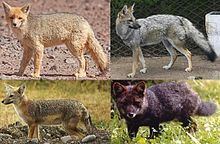Higher classification Caninae | Phylum Chordata Scientific name Pseudalopex Rank Genus | |
 | ||
Lower classifications | ||
The South American foxes (Lycalopex), commonly called raposas in Portuguese, or zorros in Spanish, are a genus of the Canidae family from South America. Despite their name, they are not true foxes, but are a unique canid genus, which some somewhat resemble foxes and are named after them. The South American gray fox, Lycalopex griseus, is the most common species, and is known for its large ears and a highly marketable, russet-fringed pelt.
Contents

The oldest known fossils belonging to the genus were discovered in Chile, and date from 2.0 to 2.5 million years ago, in the mid- to late Pliocene.

Names

The common English words "zorro" and "raposa" are loan words from Spanish and Portuguese, respectively, with both words originally meaning "fox". Current usage lists Pseudalopex (literally: "false fox") as synonymous with Lycalopex ("wolf fox"), with the latter taking precedence. The IUCN, for instance, retains the use of Pseudalopex while also acknowledging Lycalopex as a legitimate alternative.
Species
Species currently included in this genus include:


In 1914, Oldfield Thomas established the genus Dusicyon, in which he included these zorros. They were later reclassified to Lycalopex (via Pseudalopex) by Langguth in 1975.
Relationship with humans
The zorros are hunted in Argentina for their durable, soft pelts. They are also often labelled 'lamb-killers'.
